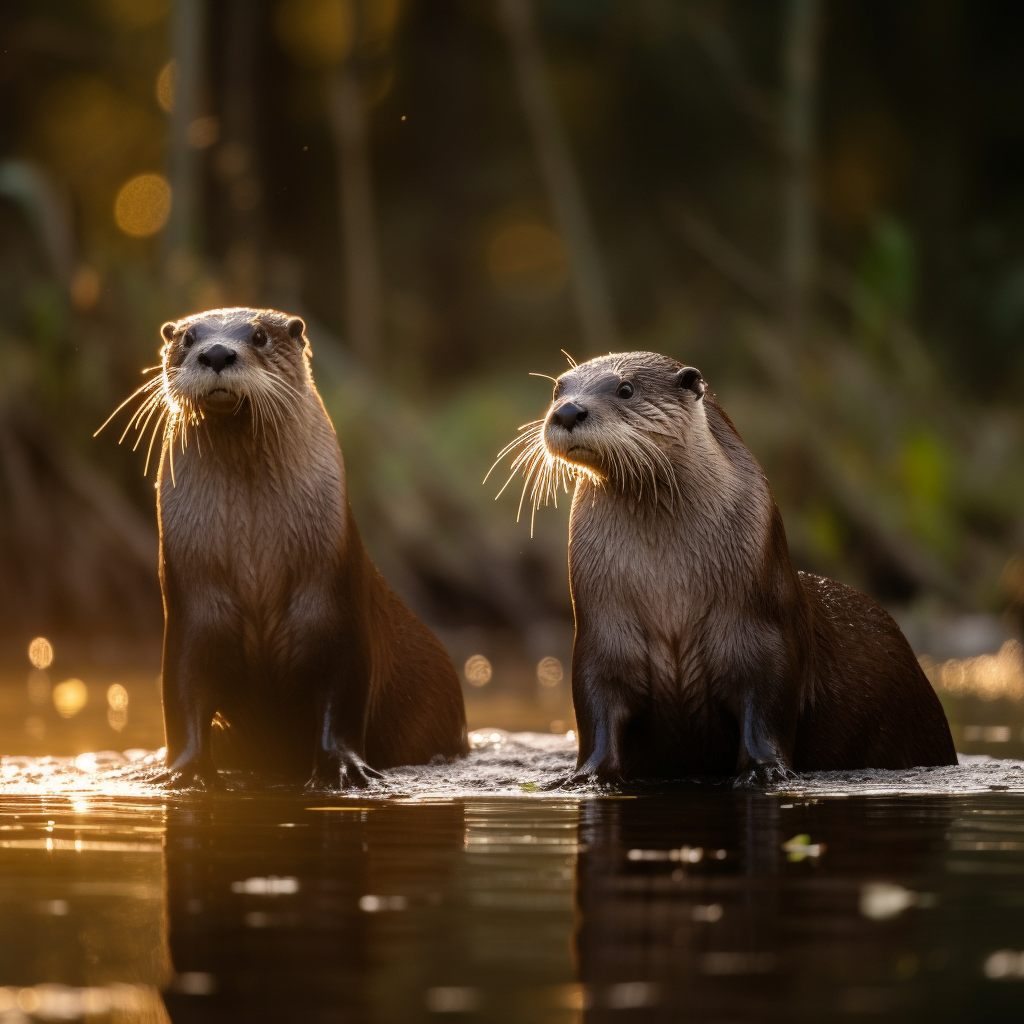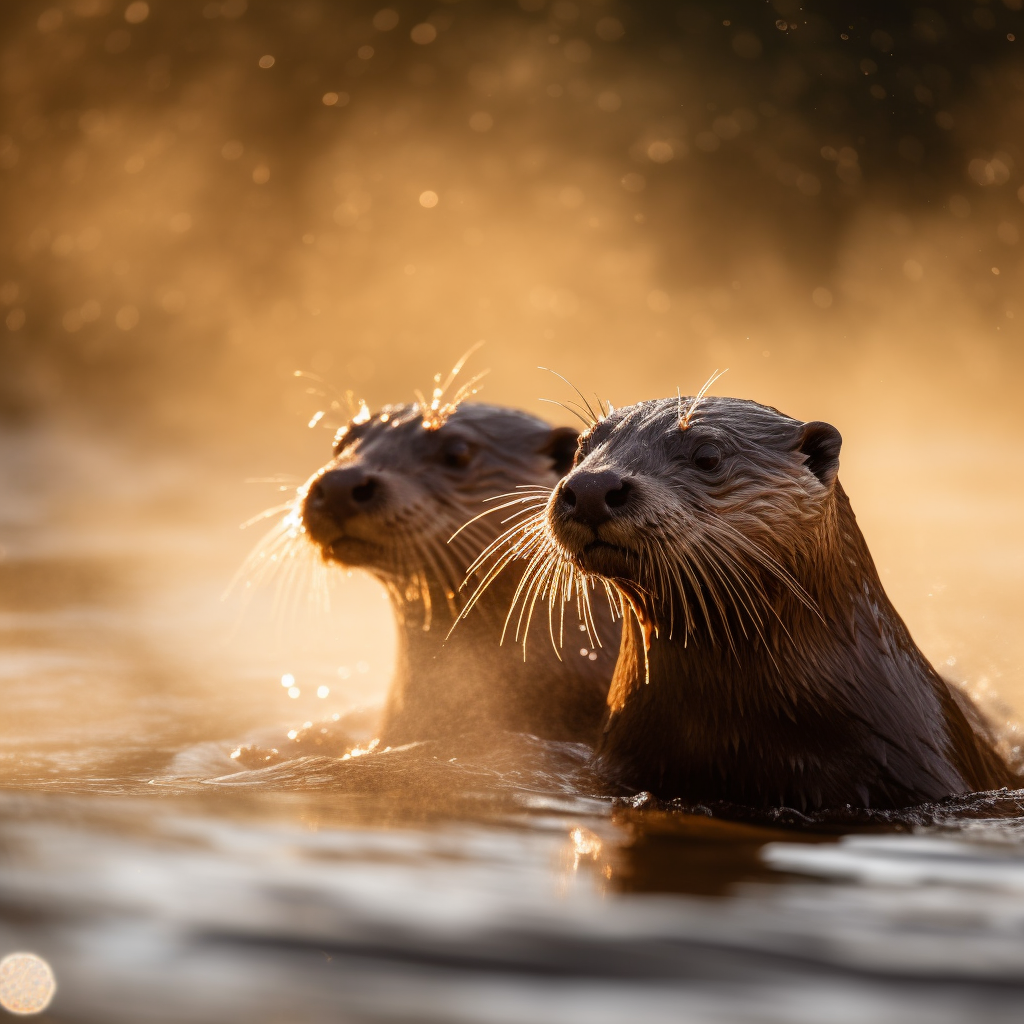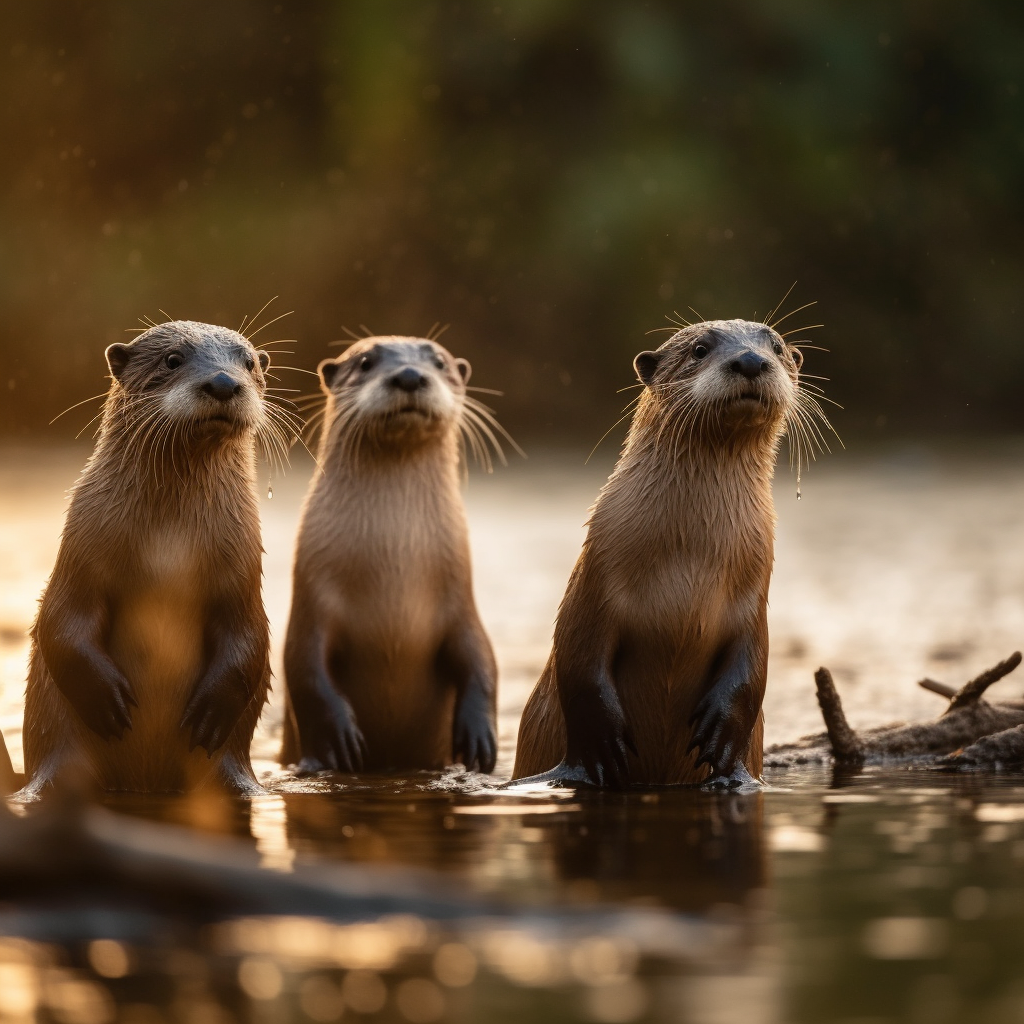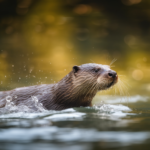River otters are fascinating creatures that can be found in the beautiful state of Louisiana. These playful and intelligent mammals are well adapted to their aquatic lifestyle, with their sleek bodies, webbed feet, and long tails. River otters are known for their excellent swimming skills and their ability to dive and catch fish underwater. In Louisiana, these charismatic animals can be spotted in various water bodies, including rivers, lakes, swamps, and marshes. They play a vital role in maintaining the health of these ecosystems by controlling populations of fish and other aquatic organisms. In this article, we will explore the world of river otters in Louisiana, their habitat, behavior, and conservation efforts to protect these amazing creatures. So, let’s dive in and discover more about the fascinating river otters of Louisiana!
Key Takeaways
- River otters are native to Louisiana and can be found in various water habitats such as rivers, lakes, and swamps.
- They are highly adaptable and have a playful nature, often engaging in sliding and wrestling activities.
- River otters play a crucial role in maintaining the ecological balance of their habitats by controlling populations of prey species.
- Conservation efforts are important to protect river otters and their habitats, as they are vulnerable to habitat loss and pollution.
- Observing river otters in their natural habitat can be a rewarding and educational experience for nature enthusiasts.
Understanding River Otters: A Closer Look

River otters are fascinating creatures that inhabit the waterways of Louisiana. In this section, we will delve deeper into the world of these playful and agile mammals, exploring their behavior, diet, adaptations, and the importance of their conservation.
Behavior and Adaptations
River otters are highly adapted to their aquatic lifestyle. They have streamlined bodies, webbed feet, and a thick layer of insulating fur that keeps them warm in the water. Their long, muscular tails help them navigate through the water with ease, acting as a rudder and propeller.
These intelligent creatures are known for their playful nature. They can often be seen sliding down muddy banks, chasing each other, or engaging in mock fights. Play is not just a form of entertainment for otters; it also helps them develop important skills, such as hunting and social interaction.
Diet and Hunting
River otters are opportunistic carnivores, meaning they will eat a variety of prey depending on what is available. Their diet primarily consists of fish, crayfish, frogs, turtles, and small mammals. They are skilled hunters, using their keen sense of smell and excellent underwater vision to locate their prey.
When hunting, otters will dive into the water and swim stealthily, using their whiskers to detect vibrations and movements in the water. They can hold their breath for several minutes, allowing them to stay submerged while they search for food. Once they spot their prey, they will use their sharp teeth and strong jaws to capture and consume it.
Habitat and Conservation
Louisiana is home to a diverse range of wetland habitats, making it an ideal environment for river otters. These habitats include swamps, marshes, lakes, rivers, and bayous. Otters play a crucial role in maintaining the health of these ecosystems by controlling populations of prey species and contributing to nutrient cycling.
However, like many other wildlife species, river otters face threats to their survival. Habitat loss, pollution, and human disturbance can all have a negative impact on otter populations. Conservation efforts, such as protecting wetland areas and implementing sustainable fishing practices, are crucial for the long-term survival of these charismatic creatures.
Spotting River Otters in Louisiana
If you’re interested in observing river otters in their natural habitat, there are several areas in Louisiana where you may have a chance to spot them. The Atchafalaya Basin, Lake Pontchartrain, and the Pearl River Wildlife Management Area are known to have healthy otter populations.
When searching for otters, it’s important to be patient and quiet. Look for signs such as tracks, slides, and scat along the water’s edge. Early morning and late afternoon are the best times to increase your chances of spotting these elusive creatures.
In conclusion, river otters are fascinating animals that play a vital role in Louisiana’s ecosystems. Their behavior, adaptations, and hunting techniques make them well-suited to their aquatic lifestyle. However, their survival is threatened by habitat loss and human activities. By understanding and appreciating these incredible creatures, we can work towards their conservation and ensure their presence in Louisiana’s waterways for generations to come.
The Geographic Spread of River Otters
River otters are fascinating creatures that can be found in various regions across North America, including Louisiana. These playful and agile mammals have adapted to a wide range of habitats, making them a common sight in many river ecosystems.
Louisiana Wildlife and Otter Habitat
Louisiana is known for its diverse wildlife and rich natural habitats. The state’s wetlands, marshes, and rivers provide an ideal environment for river otters to thrive. With an abundance of waterways and ample food sources, these charismatic creatures have made Louisiana their home.
River Otter Behavior in Louisiana
River otters are highly social animals that live in family groups called “rafts.” These rafts consist of an adult pair and their offspring from previous years. They are known for their playful nature, often sliding down muddy banks and engaging in wrestling matches with their siblings.
In Louisiana, river otters can be observed engaging in various behaviors, such as fishing, swimming, and grooming. They are excellent swimmers, thanks to their streamlined bodies, webbed feet, and muscular tails. Otters are also known for their ability to dive underwater for extended periods, allowing them to hunt for fish, crayfish, and other aquatic prey.
The Importance of Louisiana Wetlands for Otter Conservation
The wetlands of Louisiana play a crucial role in the conservation of river otters. These unique ecosystems provide otters with food, shelter, and protection from predators. The marshes and swamps offer an abundant supply of fish, amphibians, and invertebrates, ensuring a stable food source for these semi-aquatic mammals.
Conserving the wetlands is not only essential for the survival of river otters but also for the overall health of the ecosystem. Wetlands act as natural filters, purifying water and preventing flooding by absorbing excess rainfall. They also provide habitat for a wide range of plant and animal species, making them biodiversity hotspots.
Otter Spotting in Louisiana
If you’re interested in observing river otters in their natural habitat, Louisiana offers several opportunities for otter spotting. Many wildlife refuges and nature reserves in the state provide guided tours and educational programs that allow visitors to learn about these fascinating creatures.
Some popular locations for otter sightings in Louisiana include the Atchafalaya National Wildlife Refuge, the Jean Lafitte National Historical Park and Preserve, and the Kisatchie National Forest. These areas offer a chance to witness otters in action, whether they’re swimming, playing, or foraging for food.
River Otter Conservation Efforts in Louisiana
Protecting river otters and their habitats is crucial for their long-term survival. In Louisiana, various organizations and agencies are working towards otter conservation. They conduct research, monitor otter populations, and implement measures to ensure the preservation of their natural habitats.
By raising awareness about the importance of otter conservation, these efforts aim to safeguard the future of these charismatic creatures and the ecosystems they inhabit. It is essential for individuals and communities to support these initiatives and contribute to the protection of Louisiana’s river otters.
In conclusion, river otters have successfully established themselves in the diverse landscapes of Louisiana. Their adaptability, playful behavior, and reliance on wetland habitats make them a vital part of the state’s natural heritage. By understanding and appreciating these remarkable creatures, we can contribute to their conservation and ensure their continued presence in Louisiana’s rivers and wetlands.
The Reproductive Cycle of River Otters

River otters are fascinating creatures that inhabit the wetlands and rivers of Louisiana. Understanding their reproductive cycle is crucial for the conservation and management of these charismatic aquatic mammals.
Mating Season and Courtship
The mating season for river otters in Louisiana typically occurs during late winter or early spring. During this time, male otters become more active and engage in courtship behaviors to attract females. These courtship rituals involve playful chasing, vocalizations, and scent marking to establish dominance and attract potential mates.
Gestation and Birth
After successful mating, female river otters undergo a gestation period of approximately 60 to 63 days. They typically give birth to a litter of two to four pups, although larger litters are not uncommon. The female constructs a den in a secluded area near the water, such as a riverbank or marsh, to provide a safe and secure environment for her young.
Development and Maturation
River otter pups are born blind and helpless, relying entirely on their mother for nourishment and protection. The mother otter diligently cares for her offspring, nursing them and teaching them essential survival skills. As the pups grow, they begin to explore their surroundings and learn to swim, dive, and hunt under their mother‘s guidance.
Weaning and Independence
Around 10 to 12 weeks of age, river otter pups start to wean off their mother‘s milk and transition to solid food. They learn to catch fish, crayfish, and other aquatic prey, honing their hunting skills. By the age of six months, the young otters are usually proficient swimmers and are ready to venture out on their own.
Reproductive Maturity
River otters reach sexual maturity at around two to three years of age. At this stage, they leave their natal territory and seek out new habitats to establish their own territories and find potential mates. Female otters generally reproduce every two years, while males may mate with multiple females within their territory.
Conservation Considerations
Understanding the reproductive cycle of river otters is crucial for their conservation. By studying their breeding patterns and reproductive success, wildlife managers can assess the health and sustainability of otter populations in Louisiana. Protecting their habitats, such as the Louisiana wetlands, and ensuring clean waterways are essential for the long-term survival of these remarkable creatures.
In conclusion, the reproductive cycle of river otters in Louisiana is a fascinating process that involves courtship, gestation, birth, development, and maturation. By safeguarding their habitats and understanding their breeding behaviors, we can contribute to the conservation of these charismatic creatures and the delicate ecosystems they call home.
The Conservation Status of Otters: A Global Perspective

Otters are fascinating creatures that inhabit various parts of the world, including Louisiana. However, their presence is not limited to this region alone. In fact, otters can be found in many other countries, making them a globally significant species. Understanding the conservation status of otters from a global perspective is crucial to ensure their long-term survival.
The Importance of Otter Conservation
Otters play a vital role in maintaining the health and balance of river ecosystems. As semi-aquatic mammals, they are well-adapted to life in and around water. Their presence indicates the overall health of the ecosystem, as they rely on clean water and abundant food sources. By conserving otters, we indirectly protect the entire ecosystem they inhabit.
Otter Species Around the World
There are several otter species found worldwide, each with its own unique characteristics and habitat preferences. Some of the most well-known otter species include the Southern River Otter, North American River Otter, Eurasian Otter, and Giant Otter. While their appearances and behaviors may vary, all otter species share a common need for clean water and suitable habitats.
Threats to Otter Populations
Despite their importance, otters face numerous threats to their survival. Habitat loss and degradation, pollution, hunting, and climate change are some of the major challenges that otters encounter worldwide. These threats not only impact otter populations directly but also disrupt the delicate balance of river ecosystems.
Conservation Efforts
To protect otters and their habitats, conservation efforts are underway globally. Organizations and individuals are working tirelessly to raise awareness about the importance of otter conservation and implement measures to safeguard their populations. These efforts include habitat restoration, pollution control, and the establishment of protected areas.
Otter Conservation in Louisiana
In Louisiana, otters are an integral part of the state’s rich fauna. They thrive in the wetlands and waterways, contributing to the overall biodiversity of the region. Recognizing the significance of otters, Louisiana has implemented various conservation initiatives to protect these charismatic creatures. These efforts include habitat preservation, monitoring otter populations, and educating the public about the importance of otter conservation.
The Role of Individuals
While conservation organizations and government initiatives are crucial, individual actions also play a significant role in otter conservation. By adopting sustainable practices, such as reducing pollution and supporting local conservation efforts, individuals can contribute to the protection of otters and their habitats. Additionally, reporting any illegal activities, such as poaching or habitat destruction, can help authorities take appropriate action.
Conclusion
Understanding the conservation status of otters from a global perspective is essential to ensure their long-term survival. By recognizing the importance of otters and taking collective action, we can protect these remarkable creatures and the ecosystems they inhabit. Let us all join hands in conserving otters and preserving the natural beauty of our world.
Attracting River Otters: A How-To Guide
River otters are fascinating creatures that can bring joy and excitement to any outdoor enthusiast. If you’re lucky enough to live near a river or wetland area in Louisiana, you may have the opportunity to attract these playful mammals to your surroundings. In this section, we’ll explore some tips and techniques to help you create an inviting habitat for river otters.
Creating the Perfect Habitat
River otters thrive in wetland environments, so it’s important to provide them with the ideal conditions for their survival. Here are some key factors to consider when creating a habitat that will attract river otters:
-
Water Source: River otters are semi-aquatic creatures, so having a clean and reliable water source is crucial. If you have a natural stream or river nearby, that’s perfect. However, if you don’t have a water source on your property, consider creating a small pond or installing a water feature to attract these playful creatures.
-
Vegetation: River otters rely on dense vegetation along the water’s edge for cover and protection. Planting native aquatic plants and shrubs will not only provide shelter for the otters but also enhance the overall ecosystem of your property.
-
Food Availability: River otters are opportunistic feeders, consuming a variety of fish, amphibians, crustaceans, and even small mammals. To attract otters, ensure that there is an abundant food supply in the area. Stocking your pond with fish or creating fish-friendly habitats can help attract these otters to your property.
-
Safety and Security: River otters are wary creatures, so it’s important to provide a safe and secure environment. Avoid excessive noise, disturbances, or any potential threats that may scare them away. Creating a buffer zone between human activity and the otter habitat can help minimize disturbances.
Otter-Friendly Activities
Once you’ve created an inviting habitat, there are a few activities you can engage in to increase your chances of spotting river otters:
-
Quiet Observation: River otters are most active during dawn and dusk, so plan your visits accordingly. Find a comfortable spot near the water’s edge and remain as quiet as possible. Patience is key when observing wildlife, so be prepared to spend some time waiting for the otters to appear.
-
Tracking: River otters leave behind distinct tracks and signs of their presence. Look for their footprints in muddy areas near the water or their scat (feces) along the shoreline. By learning to identify these signs, you can gain a better understanding of their movements and increase your chances of spotting them.
-
Photography and Documentation: If you’re an avid photographer or nature enthusiast, capturing the beauty of river otters can be a rewarding experience. Invest in a good camera with a telephoto lens to capture their playful antics from a distance. Remember to always prioritize the well-being of the otters and avoid disturbing them for the sake of a photograph.
Conservation and Respect
While it’s exciting to attract river otters to your property, it’s essential to remember that they are wild animals and should be respected as such. Here are a few guidelines to follow:
-
Observe from a Distance: River otters are sensitive to human presence, so it’s important to maintain a safe distance and avoid approaching or feeding them. Enjoy their presence from afar and allow them to go about their natural behaviors undisturbed.
-
Avoid Disturbances: Loud noises, excessive human activity, and domestic pets can all disturb river otters. Minimize disturbances by keeping noise levels low and ensuring that pets are kept under control or away from the otter habitat.
-
Support Conservation Efforts: River otters are a vital part of the Louisiana ecosystem. Consider supporting local conservation organizations that work to protect and preserve otter habitats. By doing so, you can contribute to the long-term survival of these incredible creatures.
Creating an inviting habitat for river otters can be a rewarding experience that allows you to witness the beauty of these charismatic creatures up close. By following the guidelines outlined in this how-to guide, you can increase your chances of attracting river otters to your property while ensuring their well-being and conservation. So, get ready to embark on an otter-filled adventure and enjoy the wonders of Louisiana’s wildlife!
Conclusion
In conclusion, river otters in Louisiana play a vital role in maintaining the health and balance of the state’s aquatic ecosystems. These charismatic and intelligent creatures are well-adapted to their watery habitats and are known for their playful behavior and sleek, streamlined bodies. Despite facing challenges such as habitat loss and pollution, efforts are being made to protect and conserve these fascinating animals. Through conservation initiatives, research, and public awareness, we can ensure the continued survival and thriving of river otters in Louisiana for generations to come. So, let’s appreciate and celebrate these wonderful creatures and work towards preserving their natural habitats and the biodiversity they support.
Frequently Asked Questions
How can I attract river otters to my property?
To attract river otters, you need to ensure a suitable habitat for them. This includes a clean water source like a river or a pond, abundant food supply (they mainly eat fish, amphibians, and crustaceans), and safe places to nest and hide from predators. Remember, it’s important to respect the natural behavior and habitat of these animals and not to disturb them.
When do river otters have their babies?
River otters typically breed in late winter or early spring, and after a gestation period of about 60-86 days, the female gives birth to 1-6 pups. The pups are born between February and April.
Are there river otters in Oklahoma?
Yes, river otters are found in Oklahoma. They are primarily located in the eastern part of the state where there are abundant water resources.
Are there river otters in Georgia?
Yes, river otters are native to Georgia. They are found in a variety of habitats including rivers, marshes, and coastal areas.
Is the river otter extinct?
No, the river otter is not extinct. However, it is considered threatened or endangered in some areas due to habitat loss, pollution, and hunting. Conservation efforts are in place to protect and increase their populations.
Why is the sea otter endangered?
Sea otters are endangered mainly due to oil spills, overhunting in the past, and habitat degradation. They are also threatened by predators and diseases.
Does Louisiana have otters?
Yes, Louisiana is home to the North American River Otter. They are commonly found in the wetlands and river systems of the state.
What do river otters eat?
River otters are carnivorous. Their diet mainly consists of fish, but they also eat amphibians, crustaceans, and sometimes small mammals and birds.
Are there river otters in Louisiana?
Yes, the North American River Otter is native to Louisiana. They are often spotted in the wetlands and rivers across the state.
Are there river otters in India?
Yes, there are river otters in India. The most common species is the smooth-coated otter, found in the river systems of northern and central India.




